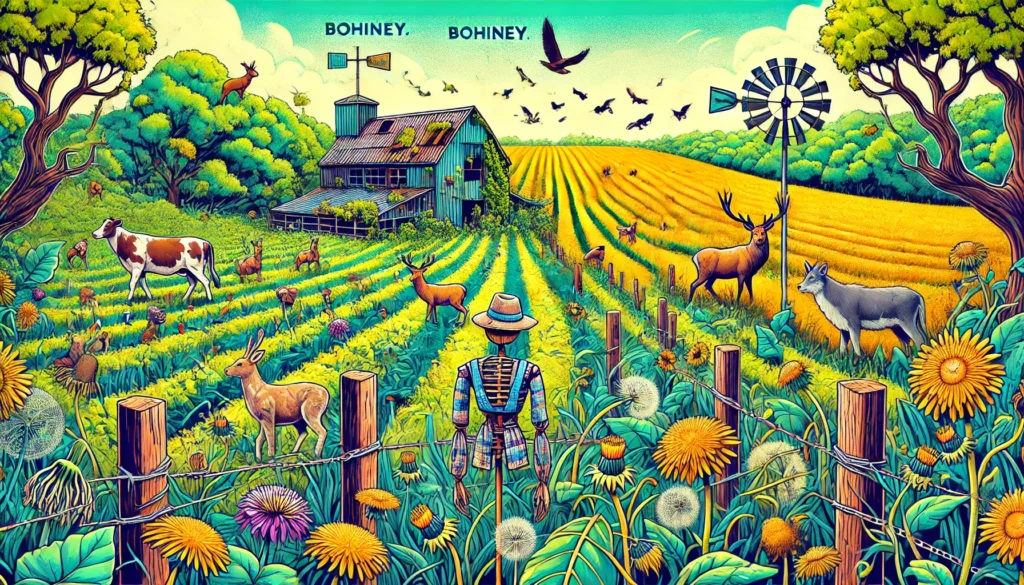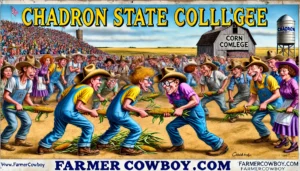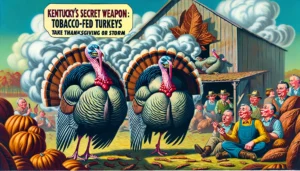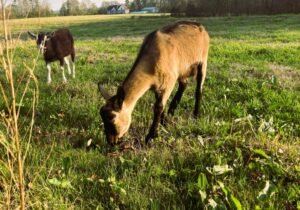
FarmerCowboy.com A vibrant illustration showing an abandoned farm being reclaimed by nature featuring overgrown weeds dandelions and w Farming Alan Nafzger 1.webp.webp
Farmers Abandoning Their Land: Is Nature Throwing a House Party?
When Farmers Pack Up, Wildlife Moves In
Scarecrows, Weeds, and the Wild Take Over the Heartland
The great American farm abandonment is sweeping the countryside, leaving fields empty and raising eyebrows about what comes next. Nature, it seems, has wasted no time stepping in to reclaim its territory. The results are equal parts ecological transformation and comedic chaos, as weeds, wildlife, and a few disgruntled scarecrows make themselves at home. Let’s explore this unexpected reshuffling of roles with humor and a side of truth.
Farmers leaving their land is like cows leaving the barn—no one knows if it’s a revolution or just lunchtime.
Nature’s Unofficial Eviction Notice
Farmers once reigned supreme over these lands, plowing, planting, and harvesting with precision. Now, with many farms left behind, nature has taken over as the new landlord. One ecologist described it as “the ultimate eviction notice.” Across the Midwest, fields once dedicated to corn and soybeans are now a chaotic blend of overgrown grasses, wildflowers, and more weeds than a teenager’s neglected backyard.
In Iowa, Rick Jensen, whose neighboring farm was recently abandoned, laughed about the swift changes. “One week it’s a field of soybeans, the next week the deer have moved in like they’ve been on the waiting list for years.”
Reports from conservation groups highlight how biodiversity explodes when farmers leave. Deer, rabbits, and birds treat the empty fields as their playground, while weeds seize their moment in the spotlight. It’s as if every dandelion and crabgrass plant across America had been holding its breath, waiting for the day the tractors stopped rumbling.
Weeds: The Unlikely Heroes (or Villains?)
With crops gone, weeds have emerged as the true winners. These plants, once viewed as nuisances, are now flourishing. Observers have likened them to “toddlers with no supervision,” overtaking fields and making themselves impossible to ignore.
One farmer-turned-realtor quipped that his abandoned field looks like “a botanical Coachella.” The sheer audacity of weeds, combined with their relentless growth, has sparked debates about whether this represents nature’s resilience or its middle finger to industrial agriculture.
Even scientists admit some grudging respect for these invaders. A study found that within months of abandonment, most fields become unrecognizable, overrun with opportunistic plant species. For weeds, it seems, every abandoned farm is a golden ticket to thrive without competition. “They’ve been waiting centuries for this moment,” said one ecologist.
Wildlife: Movers and Shakers
If weeds are the decorators of these newly abandoned landscapes, wildlife are the VIP guests at the housewarming party. Deer, squirrels, and even raccoons are flourishing in these reclaimed spaces. Reports from rural Ohio suggest a standoff between a herd of deer and a construction crew trying to develop an old farmstead. The deer, undeterred, refused to budge, asserting their newfound territorial rights.
Photographer Janet Lee recounted her surprise when she visited an abandoned field for a nature shoot. “It was like a Disney movie come to life. Deer grazing, rabbits hopping, birds singing—until a raccoon stole my sandwich. They’re really settling in.”
The transformation is as dramatic as it is sudden. Wildlife populations near abandoned farms are rising, with some areas seeing a 40% increase in deer numbers within a year. It’s nature’s version of “out with the old, in with the wild.”
Scarecrows: A Forgotten Workforce
Not everyone is celebrating the farmer exodus. Scarecrows, once the unsung heroes of the agricultural world, are being left behind in the shuffle. On many abandoned farms, they stand as sad reminders of their former purpose. One particularly poignant scene in Kansas featured a scarecrow holding a handmade sign that read, “Will Work for Crops.”
Agricultural historians lament the loss of these iconic figures. “Scarecrows are the ultimate victims here,” noted one researcher. “Without crops to protect, they’ve been reduced to lawn ornaments.” Some have even speculated about organizing a “Save the Scarecrows” campaign to repurpose these forgotten symbols for urban gardens.
The scarecrow crisis is yet another reminder that when farms disappear, so do the roles they supported—however symbolic or quirky those roles might be.
The Soil’s Quiet Rebellion
Without farmers to tend the land, soil is left to its own devices. And, like a teenager left home alone, it often makes some questionable choices. Without crops to anchor it, erosion becomes a major issue. On some abandoned farms, the once-rich soil is literally blowing away, turning fields into dusty wastelands.
Retired farmer Hank Davis recounted his visit to an old neighbor’s property. “The soil looked like it had just given up. It was like watching a sandcastle get washed away at high tide.” Scientists are quick to point out that soil needs stability, and abandoned farms often fail to provide it. Left untended, the land begins to lose its integrity—a reminder that even nature needs a little structure.
The Great Turf War: Wildlife vs. Developers
As abandoned farms continue to multiply, they’ve become prime real estate for developers. But not everyone is on board. Wildlife has made it clear that they’re not giving up their new digs without a fight. This growing conflict between nature and human ambition has created some amusing—and occasionally dramatic—standoffs.
In one notable case, a planned housing development was halted when a group of turkeys decided to roost on the construction site. “They’ve got squatter’s rights now,” joked the lead contractor, who admitted he hadn’t anticipated feathered resistance.
For conservationists, this is a silver lining to farm abandonment. They argue that these reclaimed spaces offer a rare opportunity to balance development with ecological restoration. “Nature’s doing its part,” said one advocate. “Now it’s up to us to meet it halfway.”
Insider Tips for Handling Abandoned Farmland
With so much upheaval, what’s the best way to navigate the new reality of abandoned farms? Experts recommend creative approaches to make the most of these spaces. For farmers looking to leave, partnering with conservation groups can transform fields into wildlife habitats, ensuring that nature’s takeover is beneficial rather than chaotic.
For developers, patience is key. Remember, you’re not just competing with weeds and erosion—you’re up against raccoons with an attitude. And for wildlife, the advice is simple: stay cute. It’s much harder to bulldoze a field full of frolicking deer.
Conclusion: Nature’s Not Waiting for an Invite
Farmers may be stepping away, but nature isn’t hesitating to move in. Whether it’s weeds taking over, wildlife making themselves at home, or scarecrows wondering what’s next, the story of abandoned farmland is equal parts comedy and commentary. As one observer put it, “When the tractors stop, the party starts.”
In the end, these fields tell a story of resilience—both human and ecological. While the future of farming may be uncertain, one thing is clear: nature will always find a way to fill the gaps, weeds and all.
Originally Published at FarmerCowboy.com
2025-01-03 14:07:38
Karl Hoffman is a distinguished agriculturalist with over four decades of experience in sustainable farming practices. He holds a Ph.D. in Agronomy from Cornell University and has made significant contributions as a professor at Iowa State University. Hoffman’s groundbreaking research on integrated pest management and soil health has revolutionized modern agriculture. As a respected farm journalist, his column “Field Notes with Karl Hoffman” and his blog “The Modern Farmer” provide insightful, practical advice to a global audience. Hoffman’s work with the USDA and the United Nations FAO has enhanced food security worldwide. His awards include the USDA’s Distinguished Service Award and the World Food Prize, reflecting his profound impact on agriculture and sustainability.






